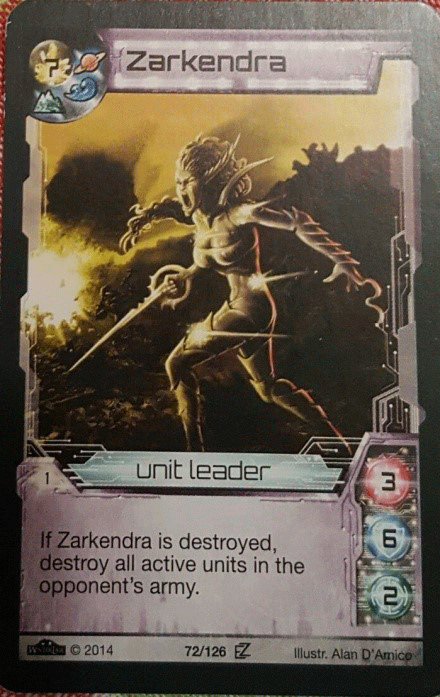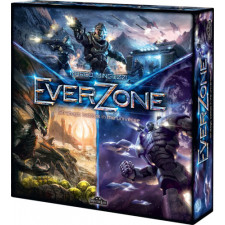EverZone Review
on Dec 21, 2016
Back when the internet was new, Wizards of the Coast created the first Never-Ending Money Suck Card Game (NEMSCG), Magic: the Gathering, and many designers have aspired to follow it. Not long afterward, and completely coincidentally, Blizzard received a change of direction from Games Workshop and created Starcraft. Fast forward (a term lost on many millennials) a couple decades, and Marco Mignozzi brings us his offering of a Magic-esque deck builder in a box, pitting three futuristic factions against each other in a tight, and surprisingly complex, battle for supremacy. Create your deck of “at least fifty†from a hundred cards, choose your battlefields and wipe your enemy from them in Everzone, an entertaining war giving players many tactical options, including the option to interpret some card effects on the fly, even after downloading new and improved rules from the internet.
Each war takes place in Prime Earth, Sea and Space, plus three battlefields chosen by each player, with all nine cards shuffled together and drawn one at a time. Each card offers three to five phases of combat, where opposing forces marshal units and support from their deck to do battle. Since cards can only be used in specific environments, what initially appears to be an odd mulligan mechanic proves to be a decent way to mitigate a deck-built force’s randomness, allowing players to discard their hand and draw again in an effort to develop a force more suited for the current battlefield.

If at first you don’t succeed…
But the battle plan only begins with marshalling. Each phase of combat has an activation limit, and shrewd generals must decide which units to bring to the fray and which to keep in reserve for future rounds. Once opposing armies are selected, they compare their total range stats to determine who gets the first shot, dealing attack damage against the defender’s armor. If the attack is absorbed, the enemy gets to fire back. If the defense value of a force is exceeded, its active units are wiped out and the player takes any extra damage as a loss to their command value. Bringing your foe’s command value to zero ends the game, and this usually occurs before the ninth and final battlefield is reached. Sometimes, in true Magic fashion, it can happen long before the end, thanks to the non-random designers’ go-to mechanic: game-breaking rules.

Even Uthron hell hath no fury…
Early games of Everzone end rapidly and with much battlefield confusion, but subsequent plays reveal deck-building and marshalling possibilities galore. Once opposing generals learn the strengths of their armies, entire battlefields will come and go without a single point lost on either side, and then an Armageddon-level combo will reveal itself, forcing quick thinking or a quick retreat, thanks to the interesting discard system. Units destroyed go to a separate pile than units who win a battle or retreat, with the latter able to be reshuffled later in the contest, should the need arise. Once this is absorbed, discarding becomes commonplace and necessary, and Everzone begins to feel more like a series of strategic battles than a randomized jumble of stats. Until the question of card ability repetition and usage comes into play.
I commend the designers for greatly expanding the original rules, but even after this additional boon, some significant questions remain. Each battle can grind to a halt after a particularly powerful card effect is played, with its owner looking at his foe and querying, “So, I can do that again?†The rules suggest that yes, you can, and some of these ambiguities can sway a battle rapidly toward one side. Cards allow generals to activate another unit, or play it from their hand, but don’t specifically state if that unit counts against the current turn’s activation limit or can participate in the current battle. Everzone’s skills and abilities make use of the “last in, first out†mechanic found in similar games, but don’t state clearly if attacks or defenses are negated by these sudden activations. In a friendly game, players are free to make snap judgments when these situations arise and move on, but they do give antagonists significant pause when they occur for the first time.
Mano-a-mano is the default combat mode in Everzone, but the rules do allow for a three-player battle, or even up to three two-player factions with shared deployment limits. These contests work fine, and can even be entertaining if you’re up for a giant battle, but the cards included in the game pretty much dictate who’s doing what, so futuristic combatants are best served in a smaller player count, allowing for maximum deck customization. Packing a lot into a small package, Everzone gives players a self-contained universe of deck-building possibilities, pitting three factions against each other in a fun, completely non-IP infringing way.

 Customer Support
Customer Support  Subscribe
Subscribe 




 Account
Account  Wishlist
Wishlist 

